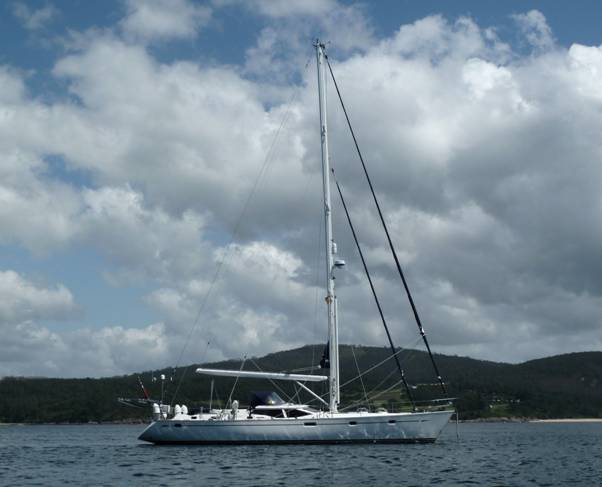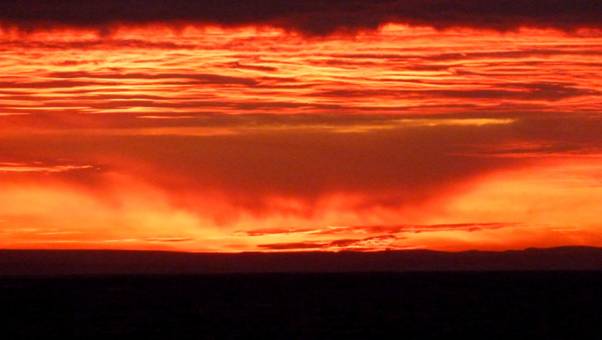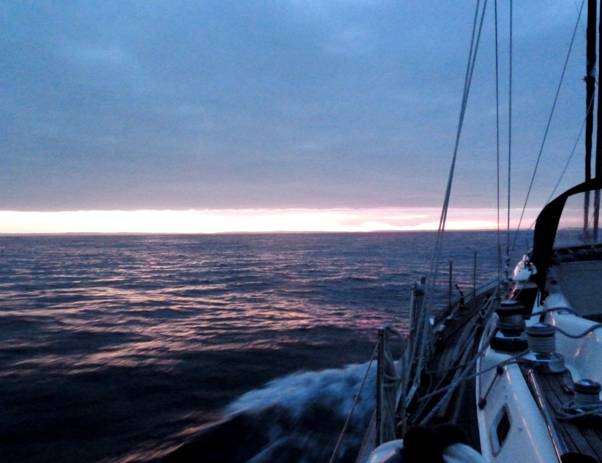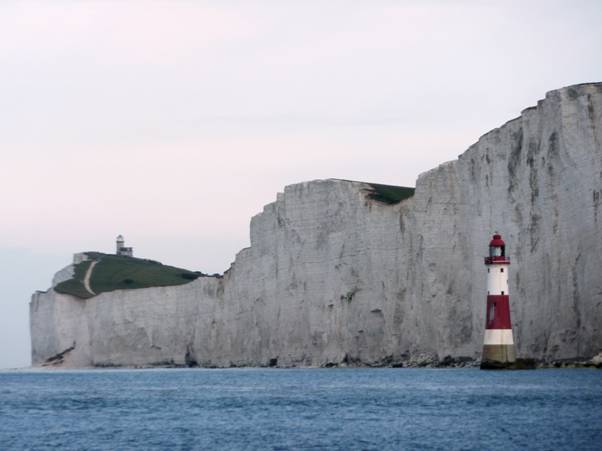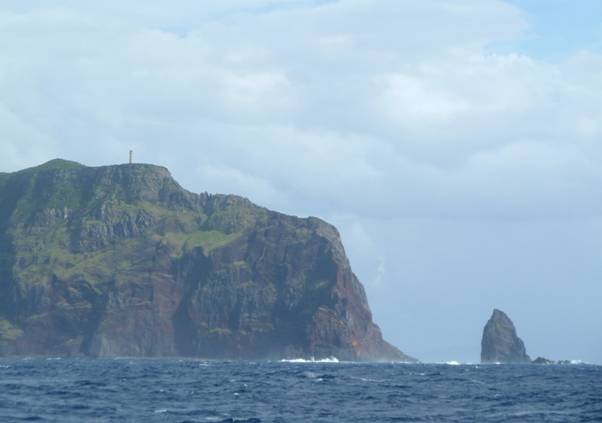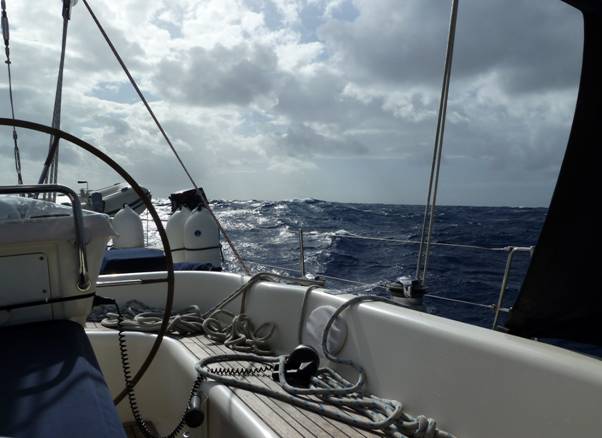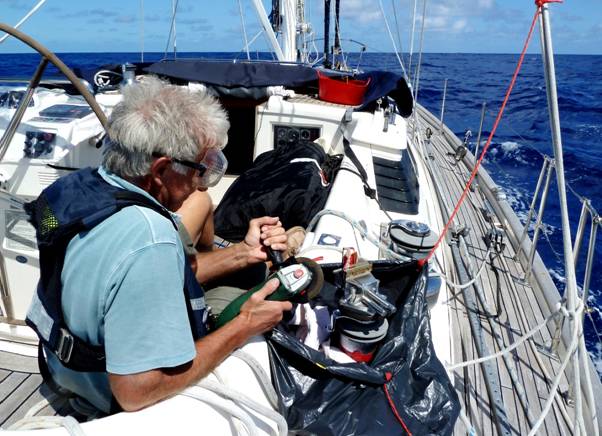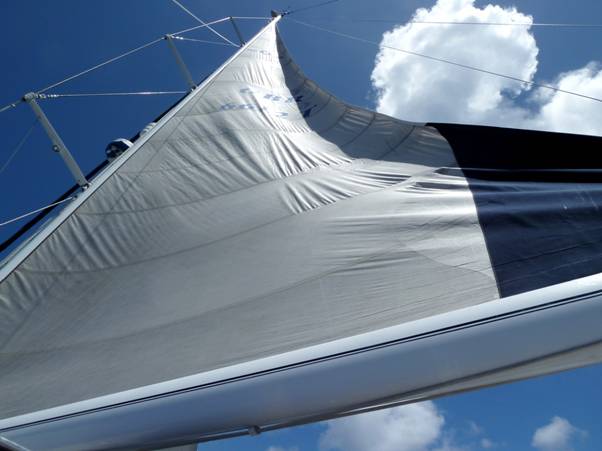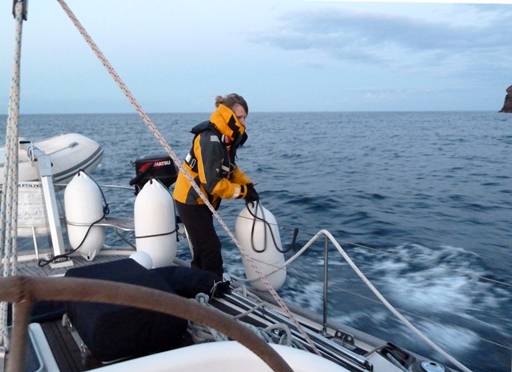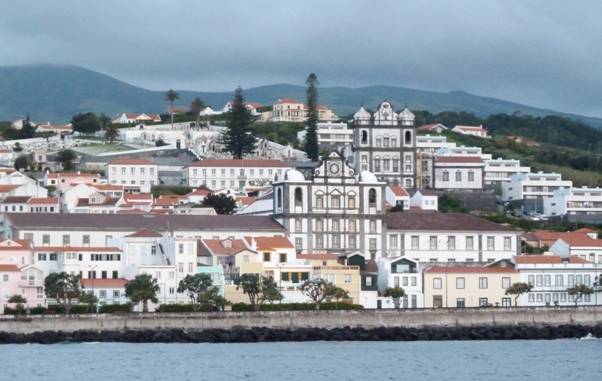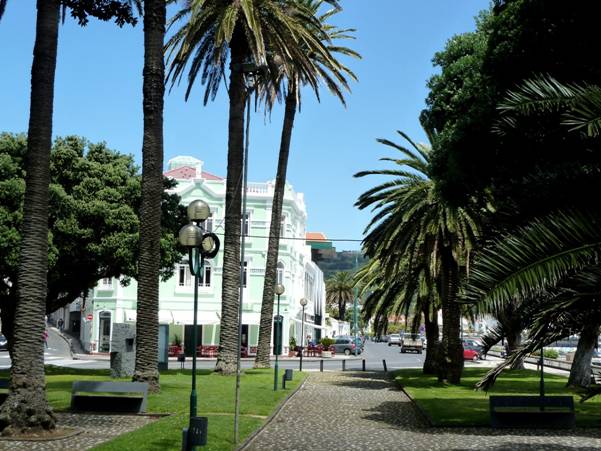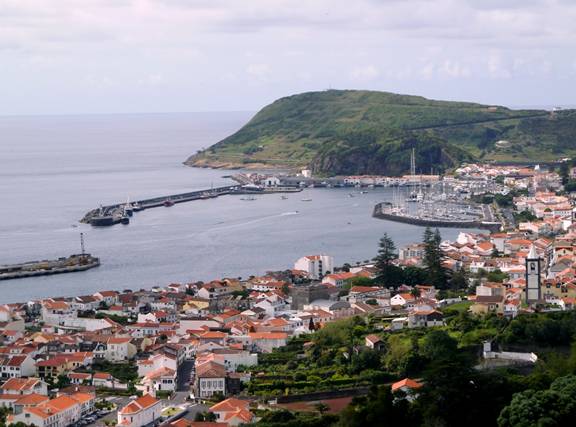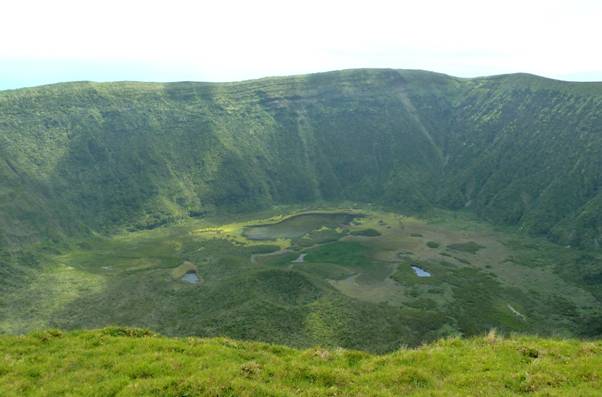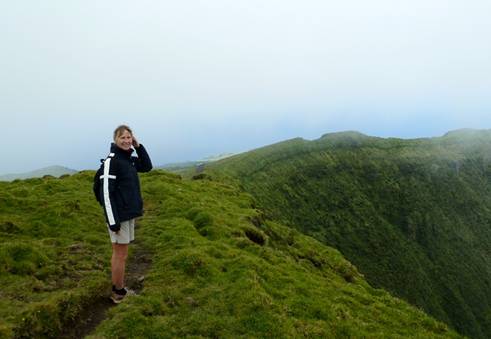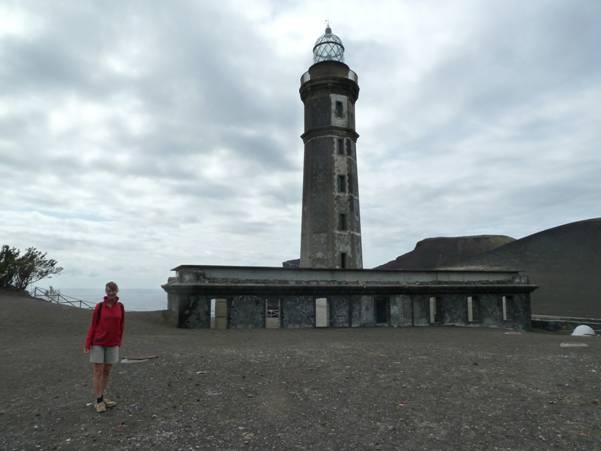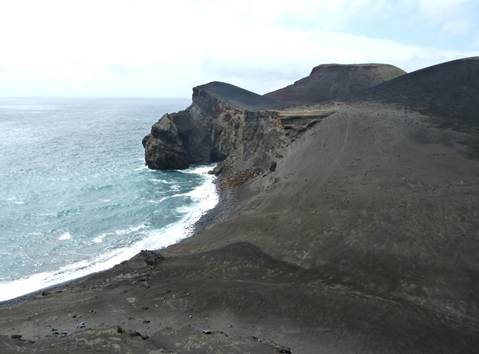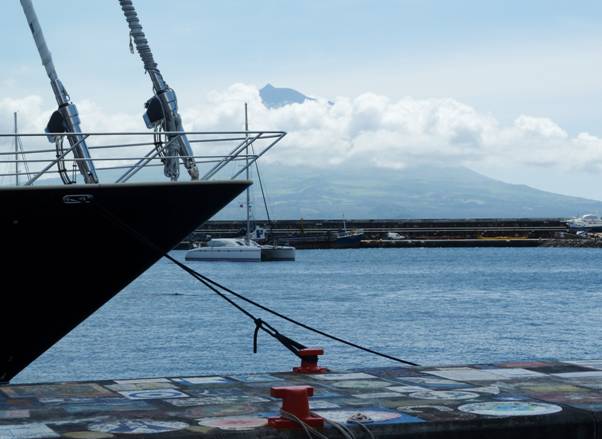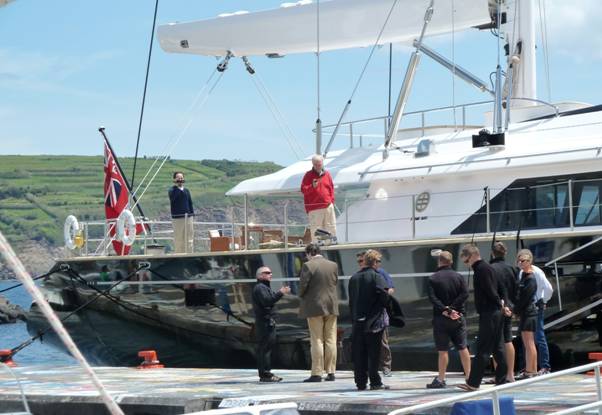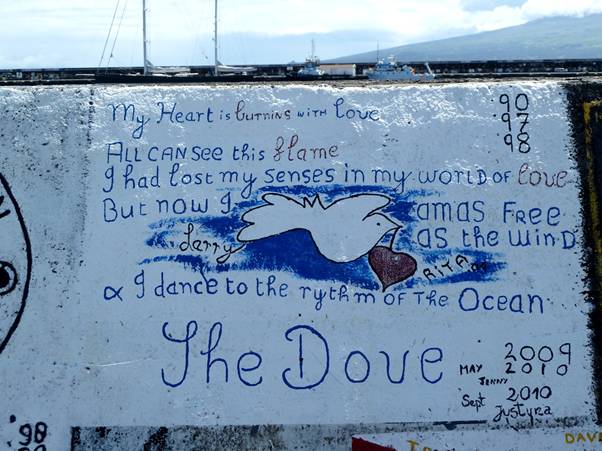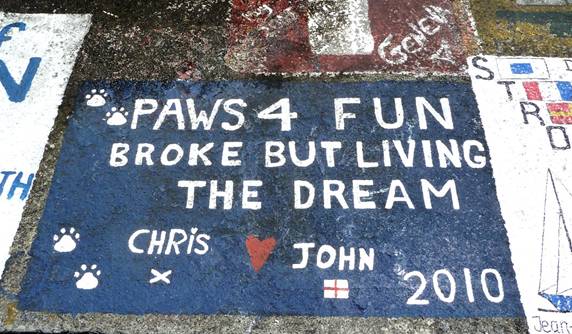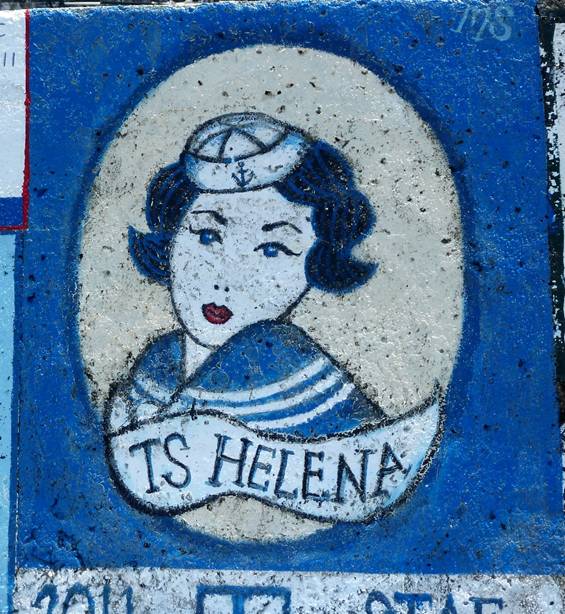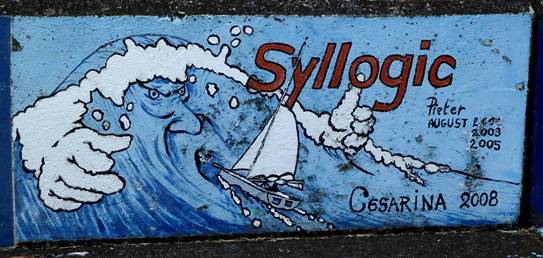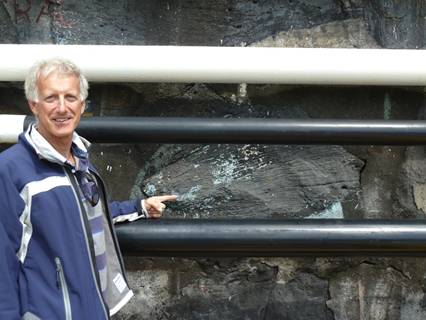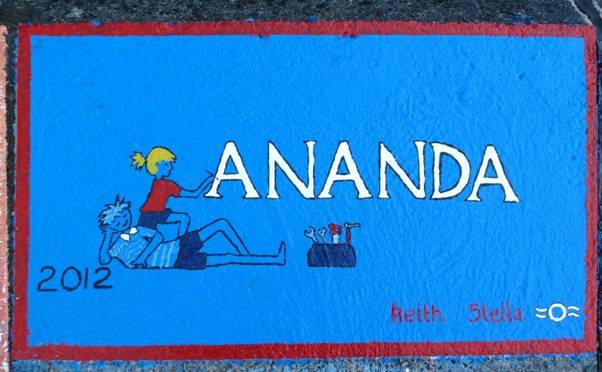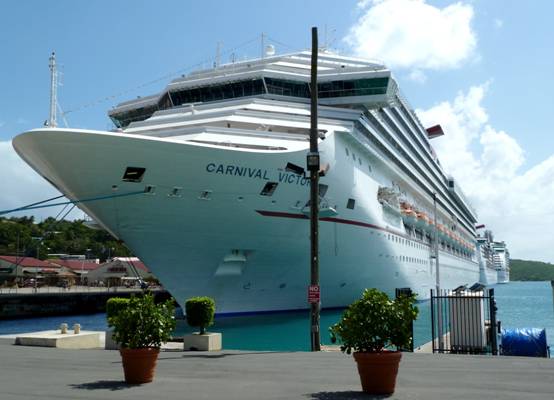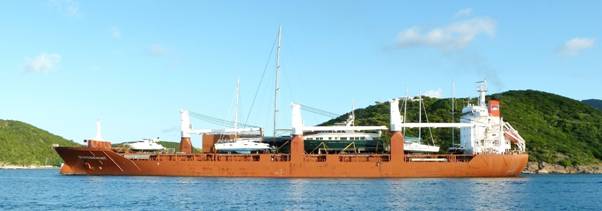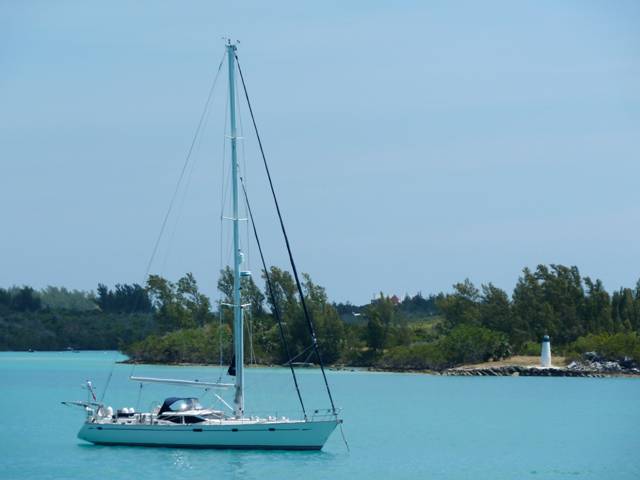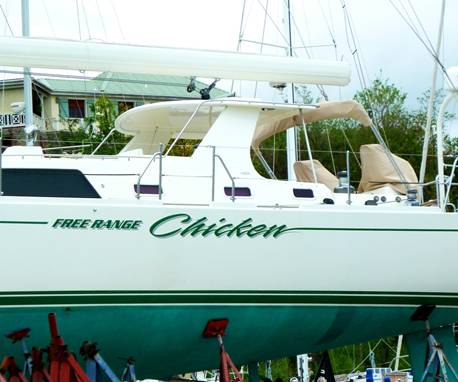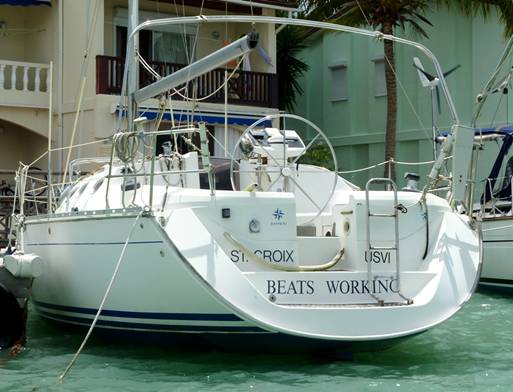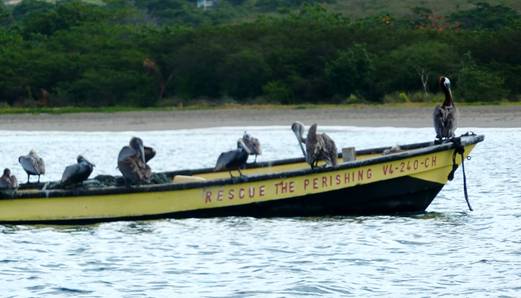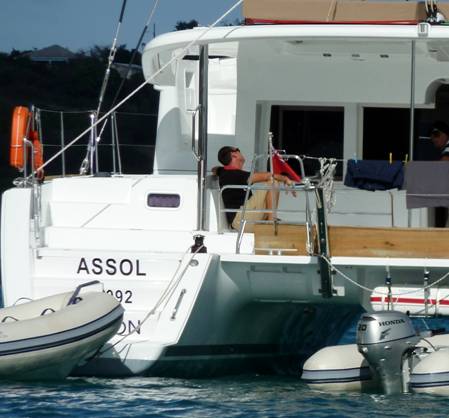Location: 18 20.64 N 64 47.35 W
Columbus had run out of saints by the time he discovered
Marie Galante so he named the island after one of his boats instead. Here, English visitors are rare. It's a quiet unspoilt haven where life goes on much the same as when we visited the Caribbean over 30 years ago.
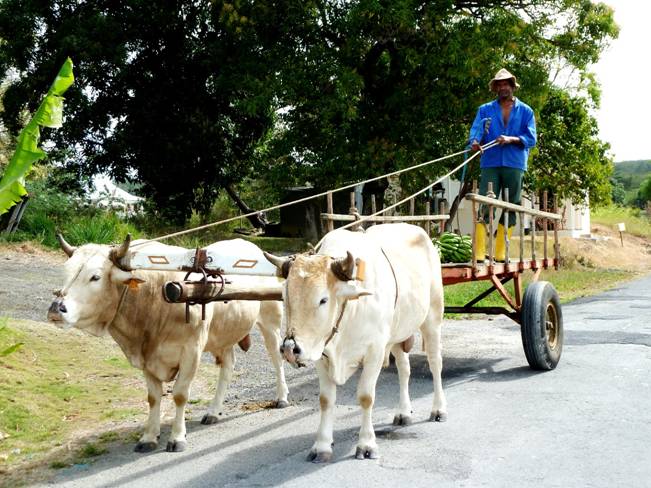 |
| Ox-drawn carts are standard transport for sugar cane on rural Marie Galante. We bought some of his delicious bananas in return for this photo. |
But we prefer horses to oxen and so hired 110 of them, harnessed into the frame of a Honda scooter, to explore along the deserted roads. With few road signs we are soon lost and stop to ask directions, but the local can't recognise any features on the map. No matter – on a round island one will inevitably end up back where one started.
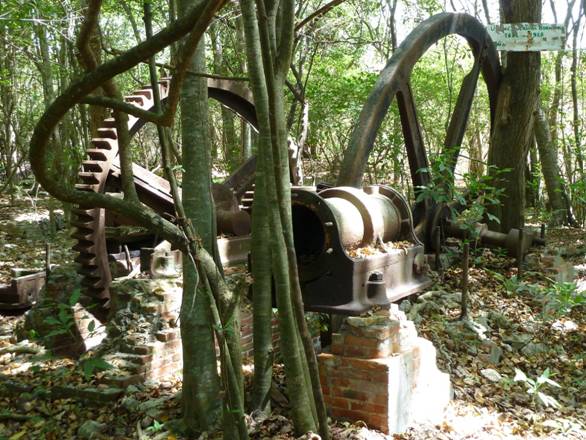 |
| Many of the old sugar mills are now in ruins and overrun by jungle. |
Abandoning the scooter we set off on an overland hike, climbing up a bluff to a plateau with paths through fields of cane.
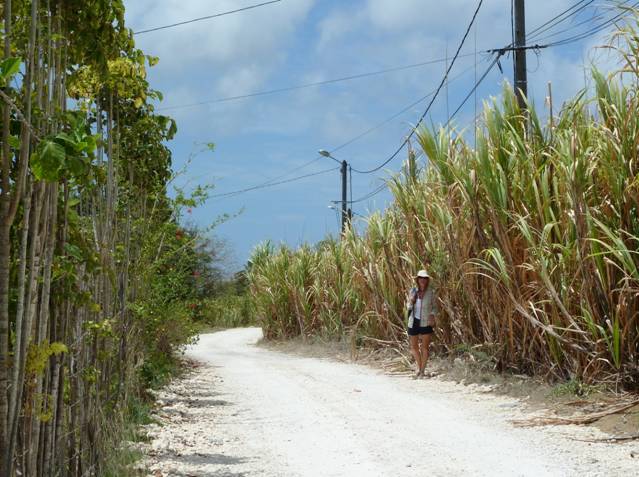 |
| Sweetness all around: Stellie dwarfed by sugar cane. It's still the most important crop here. |
It was a long walk in the heat and so we were relieved to reach 'Les Sources' , a bar run by a French lady originally from a tiny island off Brittany, for a splendid
steak frites lunch
 |
| Just because you live in a shack doesn't mean you can't keep in touch. |
The road to the limestone cliffs in the north of the island took us past local homes ranging from substantial rendered buildings to simple shacks with corrugated iron roofs and only basic furniture.
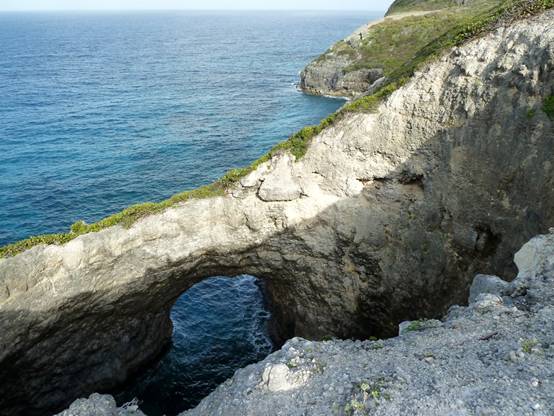 |
| Guele Grande Gouffre, Marie Galante - a 200 foot deep sink-hole complete with arch. |
Time to enjoy some more downwind sailing and so we move on again, to
Les Isles des Saintes. As a
quartier of France, this means that we can expect a plentiful supply of decent bread.
 |
| Do you want to spend more time at sea or on land? The ultimate compromise at Terre-de Haut, Isles des Saintes. |
Despite being on the cruise ship itinerary, these islands remain quaint and relatively unspoiled. Unlike most of the surrounding islands,
Les Saintes have no history of slavery and any inhabitants of African descent arrived fairly recently and, like us, by choice.
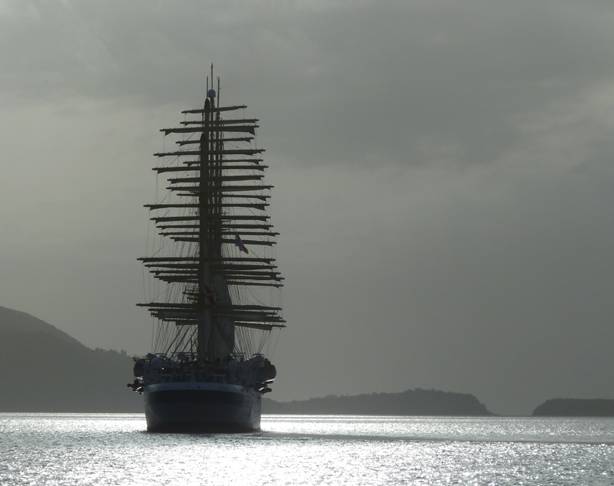 |
| The 5-masted Royal Clipper sails of into the sunset |
But unfortunately our watermaker has packed up and spare parts are needed. We arrange for these to be delivered to Antigua and sail northwards to Falmouth Harbour with its superyacht fraternity and then on to Jolly Harbour to collect our package.
Seeing the yacht
Déjà vu anchored nearby (Haven't we seen her somewhere before?) set us thinking about boat names and the thinking behind some of the more curious choices. Names range freely from the farmyard…
…through the obvious…
…to the explanatory…
…to the downright unfortunate!
Sadly the spare parts shipped from the UK don't help our watermaker to work any better and so we resign ourselves to taking on water from fuel quays – no great hardship as we can hold 1 ton of water in our tanks. But the laptop's hard drive has packed in too, playing havoc with our communications. This means I waste many hours trying to format the 'brick' – a heavy ex-military laptop designed to be run over by tanks. Eventually and with some relief I load enough programmes to regain some degree of functionality.
Rather than revisit the usual popular islands, we decide to step off the beaten track on our journey back to the Virgin Isles. To the lee of
St Barts and
St Maarten lie some unusual and very tall volcanic islands. We decide not to visit
Montserrat and its active volcano. Much of the island now has an exclusion zone and any remaining anchorages are rather exposed with the possibility of ash raining down on our decks.
So our next stop is Nevis. Although only 6 by 5 miles, the island looks like a
sombrero with its cloud-capped peak rising to over 3000 feet. The British and French fought over it until 1783 when it became British and, with its sugar plantations, prospered.
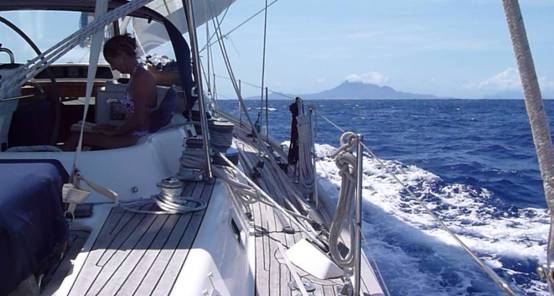 |
| Approaching Nevis. |
With few visitors other than day trippers from St Kitts, the locals are very friendly and seem genuinely pleased to see you. A walk through the main town of Charlestown reveals some lovely architecture. There are stone built houses and public buildings, and some with gingerbread woodwork on their eaves and shuttered windows.
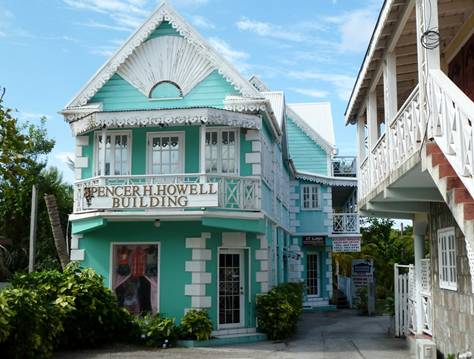 |
| Who he? Charlestown, Nevis. |
We walk along the heritage trail to the Nelson museum, but its Good Friday and closed. A pity, because the heritage of this island is fascinating.
Alexander Hamilton was born here, and Nelson married Nevisian widow Fanny Nisbett on the island. We ambled on, past the oldest hotel in the Caribbean, the Bath Hotel. A Ball was held here to celebrate Captain Horatio's wedding in 1787. And a lavish affair it was, too. There was a sit down meal for 100 guests, including Prince William Henry, the future King William IV of England.
Later, in the mid 19th Century, a 9-hole golf course, one of the first in the western hemisphere, was built here. But the hotel is no more and the building is now used as the Ministry for the island's Premier.
The next island in the chain,
St Christopher (St Kitts) is only a short 2 hour sail from Nevis and we anchor in White House Bay, a beautiful secluded spot at the unspoilt eastern end of the island. There are wild monkeys on the shoreline in the early morning, descendents of a few originally introduced by the island's early planters.
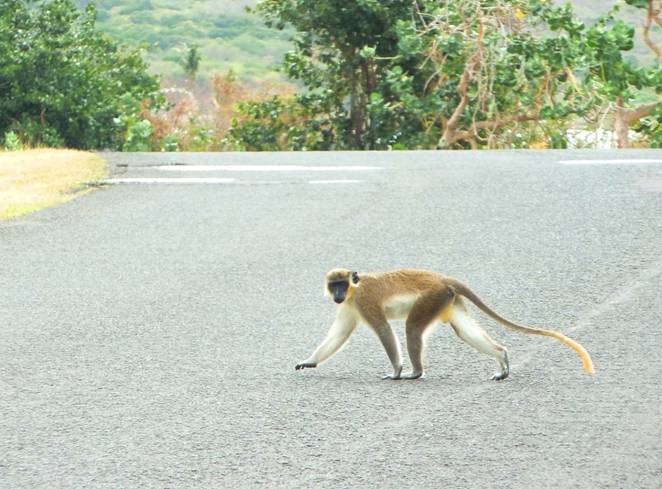 |
| African green vervet monkey, St Kitts |
But this idyll won't last much longer. The developers are already there, forging roads and selling plots for yet another marina and luxury waterside homes complex.
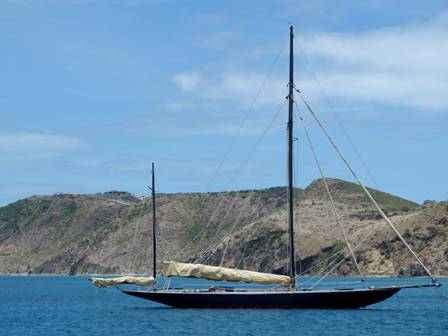 |
| Kate, at anchor in White House Bay, St Kitts. She is a replica of a McGruer 12 metre yacht, built localling in wood by Philip Walwyn. Lead for the keel was salvaged from wrecked yachts around the coastline, melted over a wood fire and cast in a concrete mold. |
Kate's owner and builder, Philip rows over and introduces himself, and gives us a wonderful sewn St Kitts courtesy flag to fly from our crosstrees! Over tea, he tells us that his family have lived on the Rawlins Plantation on St Kitts for over 250 years. His wife Kate is an artist who trained in Italy and we are invited to visit their home and studio on the plantation.
We sail down the coast to the capital of St Kitts,
Basseterre, with its interesting mixture of French and British architecture. It's a rolly old anchorage and we are pleased to go ashore to explore. Rather incongruously, the town's waterfront has been extended with a new cruise ship dock, Port Zante, that includes a 'tourist town' more in keeping with Universal Studios than a Caribbean island.
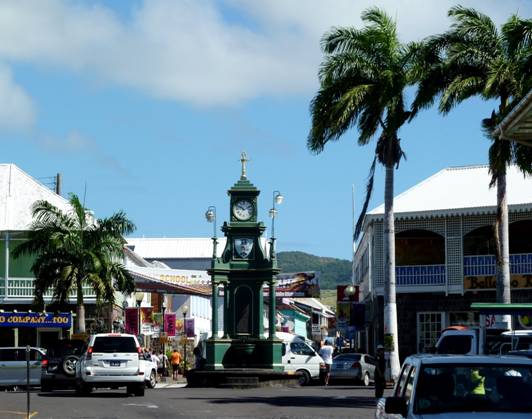 |
| The quaint Circus in Basseterre's old quarter on St Kitts was rebuilt after a fire in 1876 and is modelled after London's Piccadilly. |
But the edges of the town quickly fade into a ghetto where we feel rather unsafe. A friendly local, Reuben, escorts us back to the centre where we catch a local mini-bus to the north of the island. A sign on the bus reads 'If de music too loud you too old'. The villages we pass through are poor, and people sit by their doors gazing out at the traffic.
It's a long hike through the sugar cane fields to Rawlins Plantation. Now that it's no longer economically feasible to harvest it, the cane grows wild and untended - the industry was killed off with the introduction of sugar beet to Europe. We reach the plantation hotel and enjoy a welcome drink on the shady patio overlooking the lovely gardens.
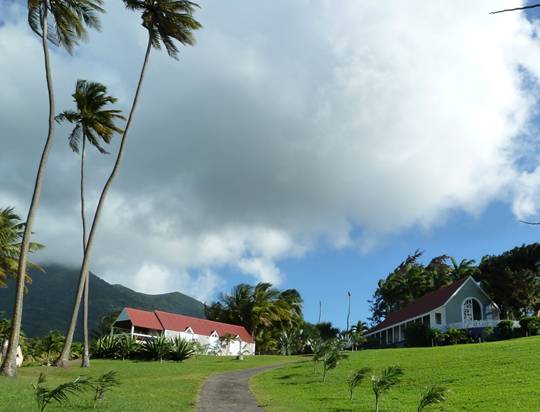 |
| Philip and Kate's studio and home at Rawlins Plantation, St Kitts |
Nearby is Philip and Kate's wonderful home where we are made most welcome and served fresh ginger and lemon tea with homemade banana bread. Kate's original art is lovely – if only our budget could run to it! At least some designer note-cards will remind us of her work.
But behind all of this idyll is another story. The (English) owner of the plantation hotel next door is in prison for murdering a white employee last year. The body was found in the cane fields below. There were many murders on this small island last year, 34 in all, though the same is almost certainly true of most Caribbean islands.
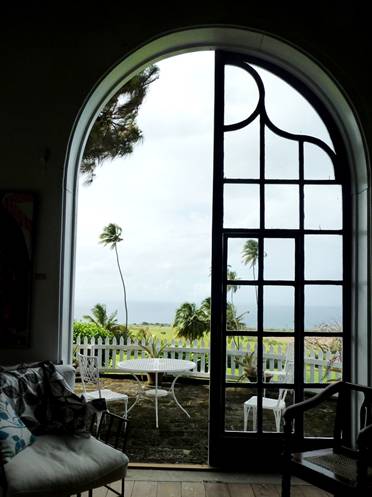 |
| A room with a view - Kate Spencer's studio |
After an early start, we sail northwards up the coast and pass Brimstone Hill, an old strategically placed fort built by the British and eventually captured by the French after a long siege. About 1000 British soldiers held out for several months against 8000 French and eventually surrendered with full honour.
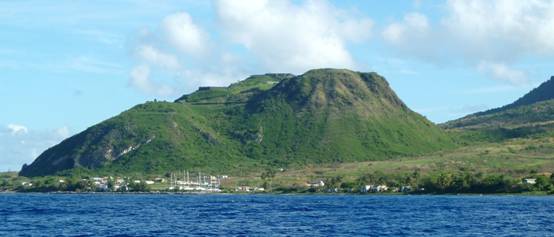 |
| Brimstone Hill, St Kitts |
It's a fast reach in lovely sunshine as we continue past
Statia (St Eustatius) towards the fairytale island of
Saba. From a distance – and close by too – it looks like a giant rock, only 5 square miles and 3000 feet high.
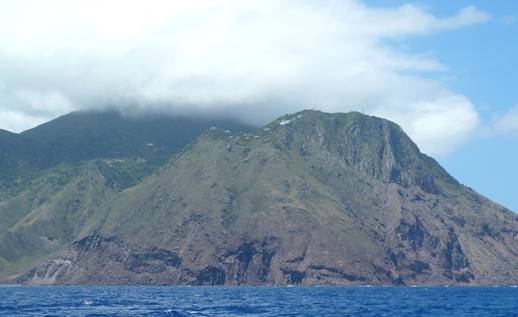 |
| Saba. The small white dots near the peak are houses. |
Until the 1940's, Saba was almost inaccessible with only one unsheltered landing spot, Ladder Bay, leading to 800 steps. Landing was only possible in calm conditions and everything had to be manhandled up the steps. Now it has a tiny harbour for dinghies and a sort-of airport that is more like an aircraft carrier, but is still pretty remote. Curiously there is now an offshore Medical School here, with students that increase the population by 50%. Not a lot of clinical experience for them on Saba, I would have thought.
The snorkelling in this remote place is superb, and we swim through beautiful coral reefs, caves and tunnels with turtles and the widest variety of fish we have seen so far for company.
But with light winds forecast within 24 hours, we leave as the sun goes down to sail for the Virgin Islands. The wind is behind us and we sail 100 miles effortlessly through the warm night, 'goose-winged' with full sails poled out either side of the boat. There is plenty of shipping about, especially cruise ships and we pass
Star Flyer and
Freedom of the Seas.
It was only later that we learned that the polite yacht that let us pass in front during the night was
Blue Pearl with our friends Steve and Dan!
By the following afternoon, after a change of plan, we are in the American Virgin Islands and snugly anchored in pretty
Caneel Bay, St John.
* * * * *

